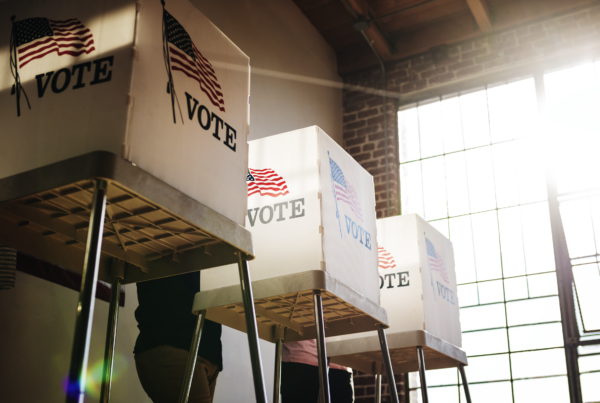![]()
(MIDDLETOWN, CT) November 1, 2018 – In partnership with the Center for Responsive Politics, the Wesleyan Media Project reports that although the proportion of dark money ads airing this year is not record-breaking, the number of dark money advertisements on television is at a four cycle high. As shown in Table 1, 243,652 dark money ads have aired in federal races from January 1 of the prior year through October 25, 2018. This represents 11 percent of airings, which is up from the 7 percent in 2016, but down slightly from 2012 and 2014 proportions.
![]()
Table 1: Dark Money in House and Senate, 2012-2018
| US House | US Senate | Total Dark | % Dark | |
|---|---|---|---|---|
| 2012 | 50,717 | 151,475 | 202,192 | 14.9% |
| 2014 | 37,432 | 161,335 | 198,767 | 14.2% |
| 2016 | 6,752 | 76,774 | 83,526 | 7.1% |
| 2018 | 74,328 | 169,324 | 243,652 | 11.2% |
| Figures are from January 1 in the first year of the cycle through October 25 in the second year of the cycle. Numbers include broadcast television. Disclosure categorization from the Center for Responsive Politics. CITE SOURCE OF DATA AS: Kantar Media/CMAG with analysis by the Wesleyan Media Project. |
||||
Table 2 shows the amount of dark money spent on behalf of Democrats and Republicans in House and Senate races between 2012 and 2018. The totals cover the full cycle through October 25 of the election year.
For Democrats in both House and Senate races, 2018 represents a high both in volume and share. Nearly 40,000 dark money ads have aired on behalf of Democratic House candidates, which is 40 percent of all outside group support for Democrats. The last time the share of dark money for Democrats approached that total was in 2012, but then the volume was just one-third what it is this cycle. In Senate races, over 90,000 dark money ads have aired for Democrats, three times the previous high in 2014.
Meanwhile, for Republicans, dark money totals are down in Senate races compared to 2012 and 2014, but they are roughly comparable to 2012 and 2014 House races. Still, the percentage of outside spending that is dark money on behalf of Republicans is much lower than 2012 and 2014. For the first time in this time series, the share of Democratic dark money in 2018 exceeds the share of Republican dark money.
![]()
Table 2: Dark Money in House and Senate by Party, 2012-2018
| Dem Dark $ | GOP Dark $ | |||
|---|---|---|---|---|
| House | Ad Airings | % | Ad Airings | % |
| 2012 | 13,099 | 35.2% | 37,618 | 63.7% |
| 2014 | 7,730 | 21.9% | 29,702 | 59.1% |
| 2016 | 3,319 | 9.7% | 3,433 | 13.2% |
| 2018 | 39,693 | 40.5% | 34,635 | 27.6% |
| Senate | ||||
| 2012 | 19,993 | 31.2% | 131,482 | 80.8% |
| 2014 | 32,505 | 25.2% | 128,830 | 62.6% |
| 2016 | 21,012 | 18.1% | 55,762 | 34.5% |
| 2018 | 91,169 | 43.4% | 78,155 | 38.8% |
| Figures are from January 1 in the first year of the cycle through October 25 in the second year of the cycle. Numbers include broadcast television. Disclosure categorization from the Center for Responsive Politics. CITE SOURCE OF DATA AS: Kantar Media/CMAG with analysis by the Wesleyan Media Project. |
||||
About This Report
Data reported here from Kantar Media/CMAG do not cover local cable buys, only broadcast television, national network and national cable buys.
The Wesleyan Media Project (WMP) provides real-time tracking and analysis of political advertising in an effort to increase transparency in elections. Housed in Wesleyan’s Quantitative Analysis Center – part of the Allbritton Center for the Study of Public Life – the Wesleyan Media Project is the successor to the Wisconsin Advertising Project, which disbanded in 2009. It is directed by Erika Franklin Fowler, associate professor of government at Wesleyan University, Michael M. Franz, professor of government at Bowdoin College and Travis N. Ridout, professor of political science at Washington State University. WMP staff include Laura Baum (Project Manager), Dolly Haddad (Project Coordinator) and Matthew Motta (Research Associate).
The Wesleyan Media Project is supported by Wesleyan University and the John S. and James L. Knight Foundation. Data are provided by Kantar Media/CMAG with analysis by the Wesleyan Media Project. WMP is partnering again this year with the Center for Responsive Politics, to provide added information on outside group disclosure.
Periodic releases of data will be posted on the project’s website and dispersed via Twitter @wesmediaproject. To be added to our email update list, click here.
For more information contact:
Lauren Rubenstein, lrubenstein@wesleyan.edu, (860) 685-3813
About Wesleyan University
Wesleyan University, in Middletown, Conn., is known for the excellence of its academic and co-curricular programs. With more than 2,900 undergraduates and 200 graduate students, Wesleyan is dedicated to providing a liberal arts education characterized by boldness, rigor and practical idealism. For more, visit wesleyan.edu.
About the John S. and James L. Knight Foundation
Knight Foundation is a national foundation with strong local roots. We invest in journalism, in the arts, and in the success of cities where brothers John S. and James L. Knight once published newspapers. Our goal is to foster informed and engaged communities, which we believe are essential for a healthy democracy.




